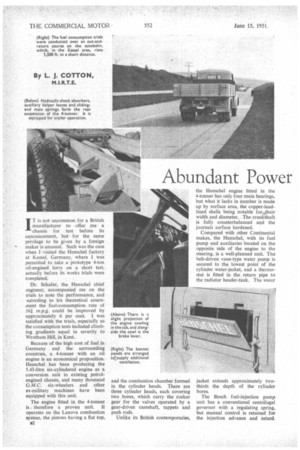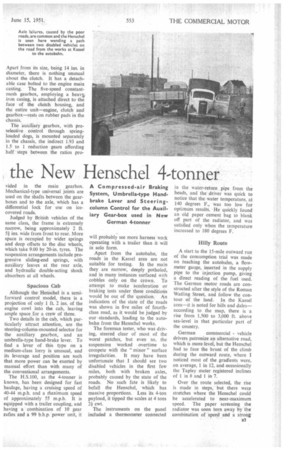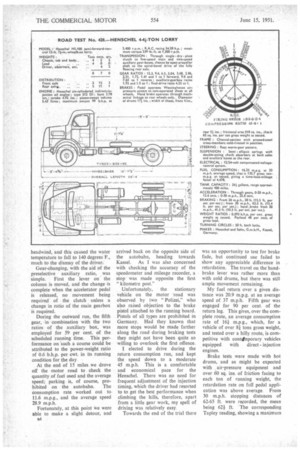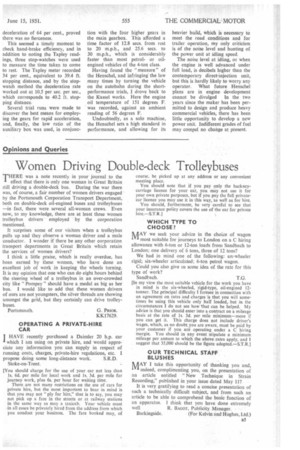Abundant Power the New Henschel 4-tonner
Page 36

Page 37

Page 38

Page 39

If you've noticed an error in this article please click here to report it so we can fix it.
By L. J. COTTON, M.I.R.T.E.
IT is not uncommon for a British manufacturer to offer me a chassis for test before its announcement, but for the same privilege to be given by a foreign
.. maker is unusual. Such was the case when I visited the Henschel factory at Kassel, Germany, where I was permitted to take a prototype 4-ton oil-engined lorry on a short test, actually before its works trials were completed.
Dr. Schafer, the Henschel chief engineer, accompanied me on the trials to note the performance, and according to his theoretical assessment the fuel-consumption rate of 16f m.p.g. could be improved by approximately 6 per cent. I was satisfied with the trials, especially as the consumption tests included climbing gradients equal in severity to Wrotham Hill, in Kent.
Because of the high cost of fuel in Germany and the surrounding countries, a 4-tonner with an oil engine is an economical proposition. Henschel has been producing the 5.43-litre six-cyfindered engine as a conversion unit in existing petrolengined chassis, and many thousand G.M.C. six-wheelers and other ex-military machines have been equipped with this unit.
The engine fitted in the 4-tonner is , therefore a proven unit. It operates on the Lanova combustion system, the pistons having a flat top, B2 and the combustion chamber formed in the cylinder heads. There are three cylinder heads, each covering two bores, which carry the rocker gear for the valves operated by a gear-driven camshaft, tappets and push rods.
Unlike its British contemporaries,
the Henschel engine fitted in the 4-tomer has only four main bearings, but what it lacks in number is made up by surface area, the copper-leadlined shells being notable forg,their width and diameter. The crankshaft is fully counterbalanced and the journals surface hardened.
Compared with other Continental makes, the Henschel, with its fuel pump and auxiliaries located on the opposite side of the engine to the steering, is a well-planned unit. The belt-driven vane-type water pump is secured to the lowest point of the cylinder water-jacket, and a thermostat is fitted in the return pipe to the radiator header-tank. The water jacket extends approximately twothirds the depth of the cylinder bores.
The Bosch fuel-injection pump unit has a conventional centrifugal governor with a regulating spring, but manual control is retained for the injection advance and retard. Apart from its size, being 14 ins. in diameter, there is nothing unusual about the clutch. It has a detachable case bolted to the engine main casting. The five-speed constantmesh gearbox, employing a heavy, iron casing, is attached direct to the face of the clutch housing, and the entire unit—engine, clutch and gearbox—rests on rubber pads in the chassis. • The auxiliary gearbox, with pmselective control through springloaded dogs, is mounted separately in the chassis, the indirect 1.93 and 1.5 to 1 reduction gears affording half steps between the ratios pro vided in the main gearbox. Mechanical-type universal joints are used on the shafts between the gearboxes and to the axle, which has a differential lock for use on icecovered roads.
Judged by British vehicles of the same class, the frame is extremely narrow, being approximately 2 ft. 51 ins, wide from front to rear. More space is occupied by wider springs and deep offsets to the disc wheels, which take 9.00 by 20-in. tyres. The suspension arrangements include progressive sliding-end springs, with auxiliary leaves at the rear axle, and hydraulic double-acting shock absorbers at all wheels.
Spacious Cab
Although the Henschel is a semiforward control model, there is a projection of only 1 ft. 2 ins, of the engine cowl into the cab, leaving ample space for a crew of three.
Two details in the cab, which particularly attract attention, are the steering-column-mounted selector for the auxiliary gearbox, and an umbrella-type hand-brake lever. To find a lever of this type on a medium-class lorry is unusual, and its leverage and position are such that more power can be exerted by manual effort than with many of the conventional arrangements.
The 1{.S.100, as the 4-tonner is known, has been designed for fast haulage, having a cruising speed of 40-44 m.p.h. and a thaximum speed of approximately 55 m.p.h. It is equipped with a trailer coupling, and having a combination of 10 gear ratios and a 99 b.h.p. power unit, it will probably see more harness work operating with a trailer than it will in solo form.
Apart from the autobahn, the roads in the Kassel area are not suitable for testing. In the main they are narrow, deeply potholed, and in many instances surfaced with cobbles only on the crown. To attempt to make acceleration or braking tests under these conditions would be out of the question. An indication of the state of the roads was shown in five miles of fourthclass road, as it would be judged by our ,standards, leading to the autobahn from the Henschel works.
The foreman tester, who was driving, steered clear of most of the worst patches, but even so, the suspension worked overtime to compete with the " minor " surface irregularities. It may have been unfortunate that I should see two disabled vehicles in the first few miles, both with broken axles, probably caused by the state of the roads. No such fate is likely to befall the Henschel, which has massive proportions. Less its 4-ton payload, it tipped the scales at 4 tons 2i cwt.
The instruments on the panel included a thermometer connected in the water-return pipe from the heads, and the driver was quick to notice that the water temperature, at 140 degrees F., was too low for optimum results. He quickly found an old paper cement bag to blank off part of the radiator, and was satisfied only when the temperature increased to 180 degrees F.
Hilly Route A start to the 15-mile outward run of the consumption trial was made on teaching the autobahn, a flowmeter gauge, inserted in the supply pipe to the injection pump, giving a direct reading of the fuel used. The German motor roads are constructed after the style of the Roman Watling Street, and follow the contour of the land. In the Kassel area—it is noted for hills and dales— according to the map, there is a rise from 1,500 to 3,000 ft. above sea-level in that particular part of the country.
German commercial vehicle drivers patronize an alternative road, which is more level, but the Henschel had to face the brunt of the climb during the outward route, where I noticed most of the gradients were, on average, 1 in 12, and occasionally the Tapley meter registered inclines of 1 in 8 and 1 in 7.
Over the route selected, the rise is made in steps, but there were stretches where the 'Henschel could be accelerated to near-maximum speed. The paper screening the radiator was soon torn away by the combination of Speed and a strong headwind, and this caused the water temperature to fall to 140 degrees F., much to the dismay of the driver.
Gear-changing, with the aid of the preselective auxiliary ratio, was simple. First the lever on the column is moved, and the change is complete when the accelerator pedal is released, no movement being required of the clutch unless a change in ratio of the main gearbox is required.
During the outward run, the fifth gear, in combination with the two ratios of the auxiliary box, was employed for 59 per cent. of the scheduled running time. This performance on 'such a course could be attributed to the power-weight ratio of 0.6 b.h.p. per cwt. in its running condition for the day At the end of 15 miles we drove off the motor road to check the quantity of fuel used and the average speed; parking is, of course, prohibited on the autobahn. The consumption rate worked out to 11.6 m.p.g., and the average speed 28.9 m.p.h. Fortunately, at this point We were able to make a slight detour, and 84 arrived back on the opposite side of the autobahn, heading towards Kassel. As I was also concerned with checking the accuracy of the speedometer and mileage recorder, a stop was made opposite the first " kilometre post."
Unfortunately, the stationary vehicle on the motor road was observed by two " Polizei," who also raised objection to the brake pistol attached to the running board. Pistols of all types are prohibited in Germany. Had they known that more stops would be made farther along the road during braking tests they might not have been quite so willing to overlook the first offence.
1 elected to drive during the return consumption run, and kept the speed down to a moderate 45 m.p.h. This is a comfortable and economical pace for the Henschel. There was no need for frequent adjustment of the injection timing, which the driver had resorted to to get the best performance when climbing the hills, therefore, apart from a little gear work, my spell of driving was relatively easy.
Towards the end of the trial there was an opportunity to test for brake fade, but continued use failed to show any appreciable difference in retardation. The travel on the handbrake lever was rather more than with cold drums, but there was still ample movement remaining.
My fuel return over a given distance was 20.9 m.p.g, at an average speed of 37 m.p.h. Fifth gear was engaged for 90 per cent. of the return leg. This gives, over the complete route, an average consumption rate of 16i m.p.g., which, for a vehicle of over n tons gross weight, and tested over a hilly route, is competitive with contiinporary vehicles
equipped with direct injection engines.
Brake tests were made with hot drums, and as might be expected with air-pressure equipment and over 60 sq. ins, of friction facing to each ton of running weight, the retardation rate on full pedal application was above average. From 30 m.p.h. stopping distances of 62-65 ft. were recorded, the mean being 621 ft. The corresponding Tapley reading, showing a maximum
deceleration of 64 per cent., proved there was no fierceness.
This seemed a timely moment to check hand-brake efficiency, and in addition to noting the Tapley readings, three stop-watches were used to measure the time taken to come to rest. The Tapley meter recorded 34 per cent., equivalent to 39.4 ft. stopping distance, and by the stopwatch method the deceleration rate worked out at 10.5 per sec. per sec., which corresponds to 40.2 ft. stopping distance.
Several trial runs were made to discover the best means for employing the gears for rapid acceleration, and, finally, the low ratio of the auxiliary box was used, in conjunc
tion with the four higher gears in the main gearbox. This afforded a time factor of 12.8 secs. from rest to 20 m.p.h., and 25.6 secs. to 30 m.p.h., which is considerably faster than most petrolor oilengined vehicles of the 4-ton class.
Having found the "measure" of the Henschel, and infringing the law many times by turning the vehicle on the autobahn during the shortperformance trials, I drove back to the Kassel works. Here the engine oil temperature of 151 degrees F. was recorded, against an ambient reading of 56 degrees F.
Undoubtedly, as a solo machine, the Henschel sets a high standard in performance, and allowing for its heavier build, which is necessary to meet the road conditions and for trailer operation, my only criticism is of the noise level and hunting of the power unit at idling speed.
The noise level at idling, or when the engine is well advanced under full load, is decibels higher than the contemporary direct-injection unit, but this is hardly likely to worry any operator. What future Henschel plans are in engine development cannot be divulged In the two years since the maker has been permitted to design and produce heavy commercial vehicles, there has been little opportunity to develop a new power unit. Indifferent grades of fuel may compel no change at present.




























































































